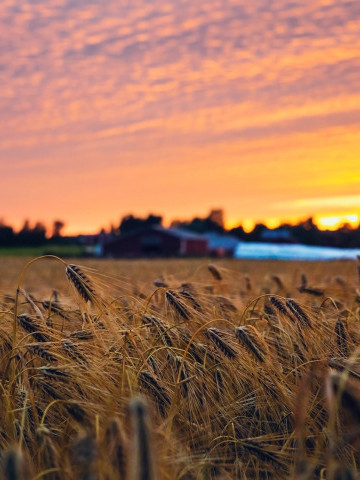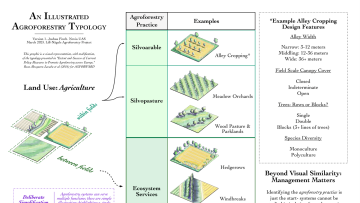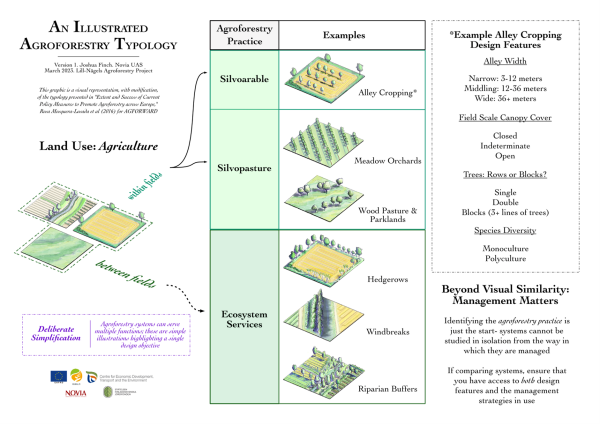
Bioekonomi
I bloggen Bioekonomi får du veta mer om Yrkeshögskolan Novias forsknings-, utvecklings- och innovationsverksamhet inom forskningsområdet systemomställning för att bygga resiliens. Majoriteten av personalen finns huvudsakligen i Raseborg. Här bildar forskare, projektarbetare, lärare, studerande och administrativ personal en dynamisk helhet. På vår blogg kan du läsa om vilka vi är, vad vi gör och om våra resultat. Välkommen!
Vid frågor eller feedback kontakta bloggens administratör Heidi Barman-Geust (Heidi.barman-geust(a)novia.fi)
Vi följer CC BY 4.0 om inget annat nämns.
Systemic Transformation to Build Resilience is one of Novia University of Applied Sciences six' research areas. The activity is mostly located in Raseborg, in southern Finland. As a dynamic unity, our researchers, project workers, teachers, students and administrative personnel produce versatile results in research, development and innovation. We blog about who we are, what we do, what our conclusions are, and how we implement them. Welcome!
If you have questions, please contact Heidi Barman (Heidi.barman-geust(a)novia.fi)
We folllow CC BY 4.0 if nothing else is stated.
Reaching Agroforestry’s Full Potential with Successional Agroforestry?

Article purpose- take a look at the main recommendations for getting the most out of agroforestry from the paper titled:
“Multifunctionality of temperate alley-cropping agroforestry outperforms open cropland and grassland”
How are we approaching these same questions at our project?
Primary reference:
Veldkamp, E., Schmidt, M., Markwitz, C., Beule, L., Beuschel, R., Biertümpfel, A., … , Corre, M. (2023). Multifunctionality of temperate alley-cropping agroforestry outperforms open cropland and grassland. Communications Earth & Environment 4, 20. https://doi.org/10.1038/s43247-023-00680-1
Introduction
Hello dear reader! I’d like to share with you a serial blog, published in three parts, about how the Lill-Nägels Agroforestry Pilot Project (LillNAP) relates to the broader story of agroforestry. I think this is particularly relevant because we are not changing one or two variables of the farming process. Every variable that could reasonably be changed has been changed. The system is oriented towards how we perceive people can assist ecological function while producing viable crops. I understand that if one approaches our project from a different perspective that this wholesale modification can make the project difficult to come to grips with.
Is our project simply an outlier? Or are the goals of our project- bioremediation of the soil, positive economic development, and community engagement- actually addressing, in their own way, questions and concerns expressed by other actors in the field of agroforestry?
To help answer those questions, this blog series reflects on some of the findings from a recently published four-year field study in Germany.
● Part 1 provides this introduction and goes into the first suggestion made by the authors of the study.
● Part 2 covers the second and third suggestion.
● Part 3 concludes this series by addressing the value proposition.
About the Study, Points of Interest
On January 24th of this year a very interesting paper was published in Communications Earth & Environment, “an open access journal from Nature Portfolio that publishes high-quality research, reviews and commentary in the Earth, environmental and planetary sciences (Commun Earth Environ, n.d.).” The paper, “Multifunctionality of temperate alley-cropping agroforestry outperforms open cropland and grassland,” was primarily written by Edzo Veldkamp and Marcus Schmidt along with 35 contributing authors (Veldcamp, et al. 2023).
Their paper addresses a lack of “comprehensive analysis” regarding the potential for temperate agroforestry to improve ecosystem function (Veldcamp, et. al. page 1). I highly encourage you to read the paper: although the technical details can be challenging, the paper reads well (a good thing for communicating one’s findings beyond experts) and serves as a good model of how thorough, multifactorial scientific inquiry can be undertaken.
The authors investigated the impact of a specific kind of agroforestry- the integration of long blocks of woody biomass producing trees with either monoculture “open croplands” or “open grasslands” across multiple farms in Germany. The authors lay out quite clearly how broad their investigation was:
“Based on the ecosystem functions considered vital in assessing the benefits of agroforestry, we quantified 47 indicators of seven ecosystem functions in croplands and 16 indicators of four ecosystem functions in grasslands, which included the following: provision of food, fiber and fuel, carbon sequestration, soil nutrient cycling, habitat for soil biological activity, soil GHG abatement, water regulation, and erosion resistance.” (Veldcamp, et. al. page 2 [Redacted footnotes and parentheses for clarity])
I was pleased to see how the researchers moved well beyond simple yield measurement, taking additional steps to determine the quality of the yields and even disease pressure on the agricultural crops.
Instead of exploring the details of their study, I’d like to bring your attention to what I found most noteworthy: three recommendations on how to realize the “full ecological and economic potential of agroforestry (Veldcamp, et. al. page 2).” I’ll walk through each suggestion as it relates to our system.
In addition to their short list of crucial suggestions, they also present a rather interesting twist on the question of farmer interest and motivations to implement these practices: “The financial compensation that the farmers perceived as necessary to encourage agroforestry establishment was much higher than the above-mentioned costs (Veldcamp, et al. page 6).” The difference between the “actual” costs of implementation and what a farmer believes is necessary reveals a very important, but often disregarded, aspect of making ideas a reality: everyone does not share the same system of values. In this case, the proverbial inputs/outputs spreadsheet is failing to capture the whole value proposition from the perspective of the farmer.
Financial cost does not equate to value, nor even to financial value. This particular lesson is one that those of us who wish to encourage farmers to engage in different practices would do well to bear in mind. If we only speak “cool and rationally” about euros and metric tons, we fail to engage with each other as people who see, feel, and experience much more than numbers.
Acknowledgement of Differences
Before jumping into the breach, it is worthwhile to pause for a moment and put this blog series into perspective.
First, I need to be clear that I am not saying that what we are doing at Lill-Nägels would be appropriate at the farms which participated in this study.

Although the systems in the paper and at Lill-Nägels include silvoarable practices, there are significant differences in the Design Features and Management which make intra-practice comparison unreasonable.
I am, however, looking at the suggestions to achieve the “full ecological and economic potential of agroforestry” presented in this paper as suggestions that could apply to most, if not all, agroforestry projects. Their suggestions transcend the particular instantiation of any one system by addressing universal issues of agroforestry design and management.
The concerns and economic feasibility perspectives of farmers also transcend the particular context of this study and are questions that farmers ask, again, about agroforestry as a whole.
Would successional agroforestry principles reduce the financial obstacles identified in the particular context of the study? Perhaps, but that would only be possible to tell if one were involved in those specific cases. I am not offering advice: I have never designed a woody biomass producing agroforestry system and have no specific knowledge of the intricacies of such an operation. Even if I were, agroforestry systems are complex and require knowledge of whole farm planning in order to succeed.
Quite simply, I was prompted to write this blog series because I have recognized these same concerns. And more pertinently, we have designed the project at Lill-Nägels to address them in our own way.
The differences in goals, scale, and management between the systems looked at in this study and the LillNAP project speak to the broad applicability of agroforestry. The “deliberate integration of woody vegetation into landscapes” is only limited to our imagination (European Agroforestry Federation, n.d.). Any implementation of an agroforestry system must be done in the context of the actual farm and their interests, goals, and financial plausibility. In practice, no two farms are the same; furthermore, no single farm would likely have a single agroforestry pattern.
Three suggestions to unlock the potential of agroforestry
Now let us begin examining their proposals in light of how we have designed the system in Kirkkonummi. Each of the following three suggestions have been incorporated into our project since its conception. The convergence of our project- which, as an applied project, is a different way of investigating ideas than a research project- with these three ideas is a positive occurrence.
Note: For each of the three ideas I am going to make the shortest possible quotation from the paper so that I can concentrate on how the suggestion relates to LillNAP. In this way the suggestions in the paper serve as a sounding board for what follows; in other words, my commentary is not precisely about what has been said in the paper more broadly.
Suggestion One: Adapt Fertilization Rates to Local Yield Levels
❖ “First, current fertilization rates need to be adapted to the local yield levels (not on generalized maximum yield potential) as over-fertilization is the major cause of inefficient nutrient use, triggering high external environmental costs.” (Veldcamp, et al. page 6)
Fertilization is a topic that we have approached at Lill-Nägels from a very different perspective than the conventional approach. I conceived the project, in part, to continue with my journey into agroecology. We have set out to explore how our management can be put in service of an agroecosystem’s ability to self organize and improve over time. Therefore, adapting our fertilization program “to the local yield levels” is part and parcel of our approach.
It should be said that one reason we have this particular field to work with is because its yields had become economically unviable. Consequently, in 2019, the field was moved into a different management system under the EU’s subsidy program which sees the bloc support farmers who set aside a portion of their farms into perennial grasslands. The whole system changed with this move: plowing, harrowing, and spraying biocides for weeds & pests was replaced with a sward of perennial grass. The subsidy program greatly restricts the kinds of activities that are allowed to take place there, including limits on fertilization.
On farm observations and benchmark soil analyses from 2022 attest to low topsoil fertility and poor soil health of the field. While significant pools of nutrients exist as reserves they are not all mobile or readily available (Lill-Nägels ‘2022 Soil Analysis’, n.d.).
So how will we adapt fertilization rates to a field that has zero local yield, low biological activity, and low nitrogen availability?
We view the lack of available nutrients and low biological activity as an opportunity rather than a challenge. Three years of mowing the field in its monoculture state did not significantly improve the soil, although it did a very good job of arresting soil erosion. In some sense the field is stabilized at a low end of succession: without a change in management, the system will only slowly begin to recover as herbaceous plants- ones that can withstand annual mowing, that is- arrive by wind and wing, engendering the functional diversity necessary for a robust plant community to emerge.
Starting near the beginning of soil development means we are in a good position to measure the impacts of farmer-supported biological remediation. A lack of readily available resources, coupled with our determination to not import large quantities of nutrients, should mean that our actions produce a clear signal. If our efforts are successful, it can not be said that we started from a uniquely advantageous soil health position.
We want to stress that we are also approaching this carefully in order to do the least amount of intervention so that the plants, unless absolutely necessary, are supported by their relationships with the soil itself. The liquid carbon pathway can be throttled by outside inputs: time the application of even organic inputs wrongly and you can sharply diminish a plant’s provision of root exudates to the soil. (Green Cover Seed, 2021). In an effort to avoid the negative compounding and cascading effects of shutting down the soil building properties of plants we will utilize foliar applications of nutrients whenever possible.
We are moderating our overarching desire to support the system’s intrinsic ability to provision nutrients through ecological pathways by importing composted horse manure, as a one time application, for the tree rows. The compost serves as a multifunctional mulch on the tree lines. Since our project is a successional system we have incorporated marketable crops from the first full growing season, namely garlic. But garlic is not an early succession, pioneer plant. While its requirement for fertile soil may not be as high as, for example, maize or pumpkins, it would not thrive without a more robust intervention than foliar nutrient applications due to the mismatch between the ideal ecological niche of garlic and the current state of affairs on site. The composted horse manure should provide essential plant-available nutrients in sufficient quantities to tidy the garlic over until April or May when foliar applications of supplemental nutrients can begin.
Composted horse manure is relatively low, when compared with other manure composts, in nitrogen and other available nutrients. This does not mean, however, that it can not contribute to over fertilization. The garlic will only use about 37% of the surface area of the tree lines at any one time. So we have planted diverse annual cover crops into the other part of the system. This diverse cover crop can likely utilize more of the plant available nutrients of the horse manure than the garlic. The plants will incorporate those nutrients into biomass largely made from atmospheric carbon. The diverse cover, then, acts as both a soil remediation pathway and as a sponge to help avoid overfertilization. Unfortunately for us the first cover crops in the summer of 2022 failed due to drought, but we will be planting new mixes again in the spring. On the bright side, failure due to drought meant that leaching of the nutrients into the soil profile was greatly reduced as well.
Over fertilization is also made more difficult in our situation because the perennial grass in the alleys and margins of the system remains intact. Despite its poor health, the grass does have a thick layer of roots from the surface down to around 20cm where the old plow pan is. Root density drops off dramatically past this point, but roots were still observed at the bottom of 50cm deep soil profiles. Some of the excess nutrition from the compost can also be absorbed by adjacent perennial vegetation.
To sum up, the desire to avoid directly interfering in the creation of a robust and complexifying soil microbiome does not mean that we will never use any fertilizer or outside inputs. Still, both why and how we intend to apply any nutrients and biostimulants (foliarly) has been reframed to center on supporting ecological function.
So ends Part 1 of this series of blogs regarding “Reaching Agroforestry’s Full Potential with Successional Agroforestry.” Part 2 will be published on 2.5.2023 and will cover the second and third suggestion.
Texten har granskats av Novias campusredaktion och publicerats 27.4.2023.
![]()
Bioekonomi
Blogginlägg som är granskat av Novias redaktionsråd är utmärkta med nyckelordet "Granskat inlägg".
Vi följer CC-BY 4.0 om inget annat nämns.
Ansvarsfriskrivning: Författaren/författarna ansvarar för för fakta, möjlig utebliven information och innehållets korrekthet i bloggen. Texterna har genomgått en granskning, men de åsikter som uttrycks är författarens egna och återspeglar inte nödvändigtvis Yrkeshögskolan Novias ståndpunkter.
Disclaimer: The author(s) are responsible for the facts, any possible omissions, and the accuracy of the content in the blog.The texts have undergone a review, however, the opinions expressed are those of the author and do not necessarily reflect the views of Novia University of Applied Sciences.